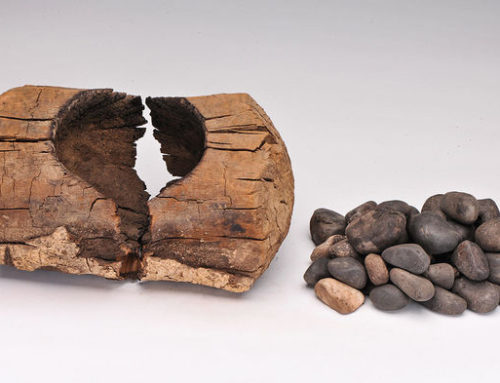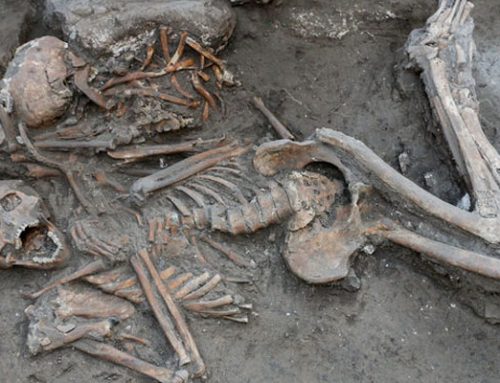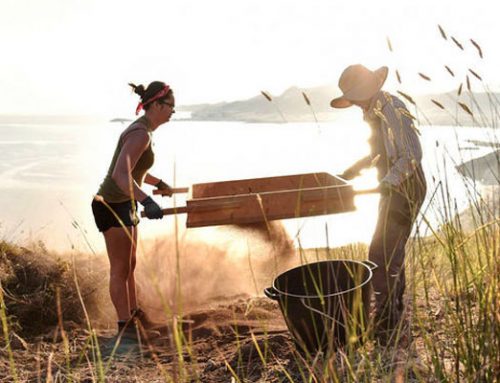Researchers suggest that the nature of pre-Viking society spurred a drive for slaves

On 8 June 793 C.E., a band of foreign warriors attacked the Christian monastery of Lindisfarne on the English coast, wrecking the church, killing the monks, and making off with all the treasure their ships could hold. This brutal attack has long been thought to mark the start of Viking aggression. But archaeologist Neil Price of Sweden’s Uppsala University suspects that the roots of the Viking era go back long before this raid.
Armed with a $6 million grant—a princely sum in archaeology—Price and his col-leagues want to know the extent to which a need for captive labor and overseas wives helped drive Viking expansion, transforming the provincial Scandinavian sailors and fur traders of the earlier Vendel period into international explorers and marauders. “The social processes are going on long before” the Lindisfarne raid, Price said after his talk at a symposium on Vikings at the annual meeting of the Society for American Archaeology here last week. “We can erase this boundary between the Vendel and Viking eras.”
A few kilometers from Price’s office at Uppsala, Viking leaders and warriors gathered each spring to plan raids on distant lands. Now, Price plans his own assault, gathering specialists from across Europe to nail down the social and economic forces that spurred the Viking phenomenon. At the meeting, he and his colleagues laid out research plans and discussed preliminary finds. Rather than excavate, the team intends to use the Swedish Research Council’s largest ever archaeological grant to reexamine spectacular existing finds using modern methods such as isotopic analysis.

Doubled-edged swords like this one from an Estonian ship burial show that Scandinavians far from their homeland fought fiercely before the accepted start of the Viking era.
“Price’s project goes to the core of the question that all Viking scholars ask: Why the Vikings?” says Jan Bill, an archaeologist at Oslo’s Museum of Cultural History. “Just putting some order into the old excavations and publishing them properly will tell us a lot about the background to the Viking age,” adds archaeologist Marek Jankowiak of the University of Oxford in the United Kingdom, who specializes in the period but also is not part of the project.
The sudden and dramatic breakout by the Vikings has long puzzled scholars. The Lindisfarne raid inaugurated 3 centuries of expansion that led to settlement of Iceland, Greenland, and, briefl y, Newfoundland in Canada. To the east, Vikings dominated the rivers of today’s western Russia and Ukraine, sent diplomats to Constantinople, and traded as far afield as Baghdad and North Africa.
But although previous scholars identified the raids as the start of the Viking era, Price stresses that their way of life began long before. In the Vendel period from about 550 C.E. to 790 C.E., Scandinavians exported iron and furs and developed impressive sea-faring skills. And between 2008 and 2012, researchers discovered two ship burials on the edge of the Baltic Sea in Estonia, 250 kilo-meters from the Swedish coast. The burials are “the most signifi cant Viking discovery of the last hundred years,” Price says—and they apparently predate the Lindisfarne raid by nearly a century, according to dating by radio-carbon and artifact styles.
Found on the island of Saaremaa in the town of Salme, the two war boats served as graves for 40 men. In one, 33 men were stacked atop one another and covered with wooden shields. Elite soldiers were buried with elaborately decorated double-edged swords, and a man who appeared to be the chieftain clasped a sword with a jeweled hilt and held a gaming piece made of walrus ivory in his mouth.
Working with Estonian collaborators, “we plan to throw massive science” at these ancient vessels to glean everything possible about this period, Price said. He’ll also focus on some spectacular ship burials at Valsgärde, just outside of Uppsala, dated from the sixth century to the 11th century. The area includes 60 tombs, including those of women, and hundreds of artifacts yet to be carefully analyzed.
Price and his colleagues wonder whether the burials will yield evidence of slavery, which they increasingly see as a powerful factor driving the Viking expansion. Price said the need for slaves may have begun during the Vendel era, when the fast-growing fl eet of ships demanded an enormous number of massive woolen sails. This required transforming land into pasture for sheep, producing wool, and making sails—a labor-intensive craft. A single 90-square-meter sail might take a single person up to 5 years to produce, said Ben Raffield, an archaeologist at Simon Fraser University in Burnaby, Canada, who is involved in the project. Price adds that “each ship needed two sails, and there were hundreds of ships,” raising the possibility that slave labor was needed to maintain the fleet.
Historical sources make it clear that the “Vikings were taking, transporting, and selling slaves,” Raffield said in his talk. He estimates that slaves comprised as much as 25% of Scandinavia’s population. Norse sagas mention slaves— “thralls” in Old Norse—who were often given pejorative names like Stinky, Stumpy, and Stupid. But compelling archaeological evidence has been elusive. Iron manacles and collars hint at slavery, but might have been used for prisoners or dogs. Raffield plans to search for evidence of special vessels designed to carry captives.
Other archaeologists have found tantalizing hints of slavery in existing remains. About one in 25 male Viking burials in Swe-den and Norway includes teeth incised with deep grooves. The marks were long thought to indicate a warrior class, but at least some of these men were decapitated and placed in a burial with another man, said Anna Kjellström of Stockholm University, who is also part of the project. “You can make a strong argument that these were special slaves who were ritually killed” upon the death of their master, she said in her talk.
“The ‘business model’ of the Baltic Vikings appears to have depended on [slavery].”
Marek Jankowiak
“The slaves may have been in front of us all the time.” The team plans extensive isotopic analysis to discover whether the victims were local or recent, perhaps involuntary, arrivals.
The research program also will analyze changes in Viking society as shown by land use. For example, by the 10th century, architectural clues to slavery become clear. At a site outside Stockholm near today’s Ikea, a small round hut dug into the ground sits on a slope above a large manor house. The hut appears to have been the living quarters for slaves at the height of Viking prosperity, said Charlotte Hedenstierna-Jonson of Stockholm University. At another Swedish site, Sanda, a large house is surrounded by much smaller structures, possible slave quarters. “It’s not going too far to see these as the big house on a plantation,” Price said.
Other researchers praise the team’s integration of details into a fuller picture of Vendel and Viking society. “It is now clear that we cannot fully understand the Vikings without taking into account slave hunting and slave trade,” Oxford’s Jankowiak said. “The ‘business model’ of the Baltic Vikings appears to have depended on it.”
The team also will tackle the disturbing issue of sexual slavery. There are hints of polygyny in Germanic cultures from this time, though researchers aren’t sure of its extent in Viking society or in the Vendel era. But if it were prevalent, Price speculates, poorer men would have been eager to seek wives outside Scandinavia. Researchers hope to understand more by pulling together DNA and other data to determine relations and origins among Viking dead.
The argument that Vikings set out to capture women gets tantalizing support from recent genetic studies of living people in Iceland, which has not experienced a significant migration since the Vikings settled it more than a thousand years ago. About three-quarters of male Icelandic settlers hailed from what is today Norway, although well over half of the women were from the British Isles, according to genetic studies of today’s Icelanders. That suggests that Viking men partnered with British women on a massive scale. “We must be talking about some degree of coercion,” Price said. His team will emphasize examining the remains of Viking women—long understudied—to understand their origins.
Price adds that much more work is required to understand the emergence of the Vikings’ raiding society. “This is just the start of a decade of research,” he says.




